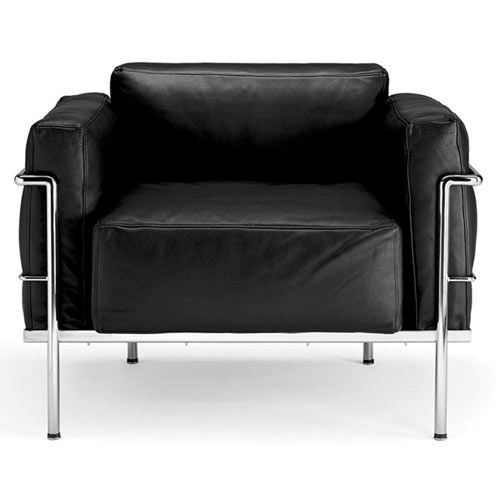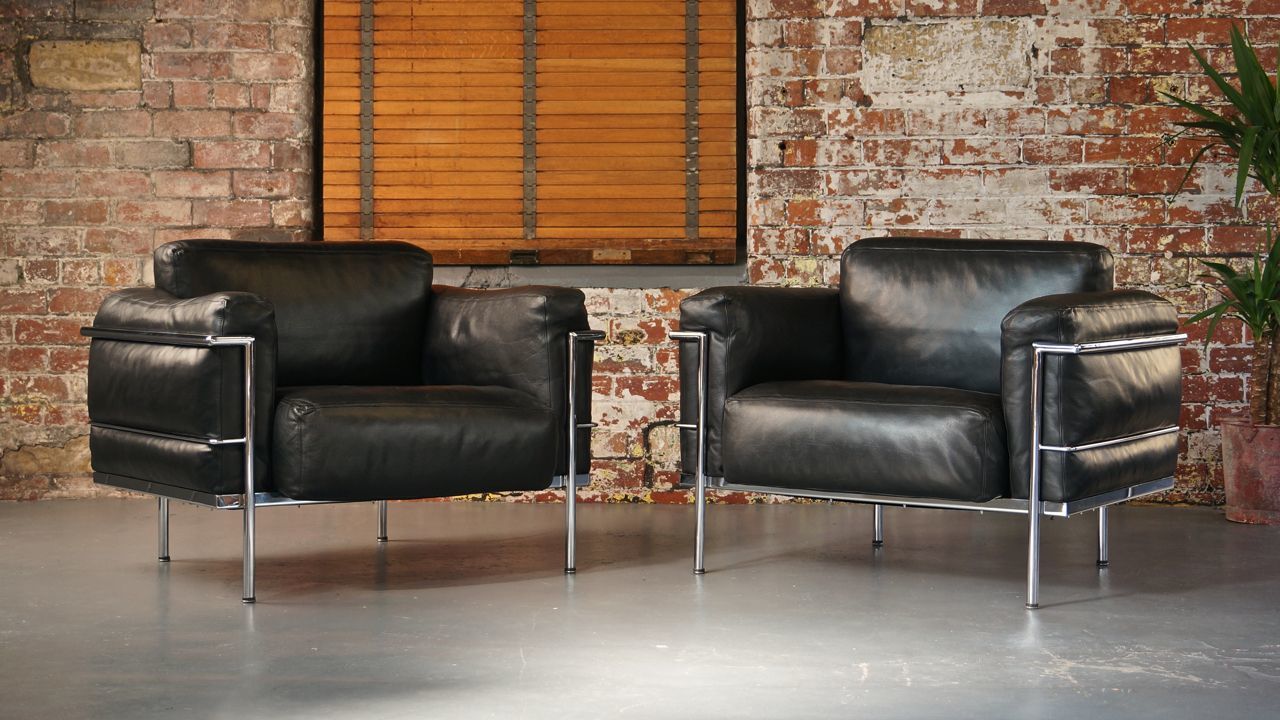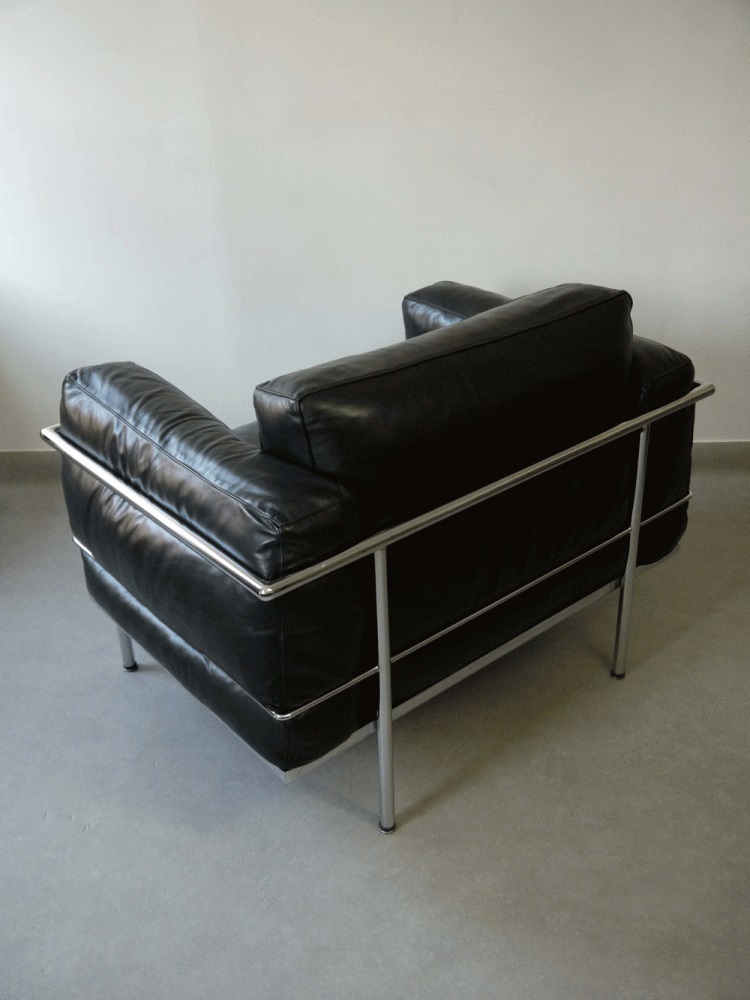Armchair with chromed steel frame, FEATHER - cushions with polyurethane insert covered with leather or fabric
dimension: 104x73x76
This is an experimental prototype of the series "Grand Confort" where we can clearly see the idea of an exterior metal framework which gathers the pillows. Later the size of the pillows were reduced and became more rigid.
Goods fully produced in Italy
Le Corbusier's six-decade career reshaped cities from South America to India. He built seventy five buildings in a dozen countries and worked on over four hundred architectural projects. He disseminated his ideas through his almost forty books and hundreds of published essays. This extensive practice, characterized by the "poetic and often provocative interpretation of the technologies and values of the new machine age," as architectural historian Kenneth Frampton puts it, established him as one of the most influential and controversial artists of the 20th century. Many of Le Corbusier's ideas, however, were too utopian to be put in practice, especially the ones reflecting his desire for a somewhat extreme control and order of society.
Architect, city planner, painter, furniture designer, writer, publisher, and amateur photographer and filmmaker, Le Corbusier introduced unconventional ideas that helped shape modern society. As suggested by Kenneth Frampton "no single scholar has been able to master all the ramifications" of Le Corbusier's creativity, not the least because Le Corbusier's perspectives and interpretations of the world and its interaction with architecture often changed and remain difficult to pin down. Thus his work continues to be studied, criticized, and reinterpreted today, gaining new meanings and influencing generations to come.
Bauhaus Classics
Η σχολή του Bauhaus ένα από τα σημαντικότερα φαινόμενα της δεκαετίας του 1920, ήταν η σχόλη που ονομαζόταν « Das Staatliche Bauhaus », η οποία δημιουργήθηκε το 1919 από τον Walter Gropius με τη συγχώνευση των σχολών καλών τεχνών και εφαρμοσμένων τεχνών, στη Βαιμάρη. Ο Gropius πίστευε στην ανάγκη ενότητας μεταξύ της αρχιτεκτονικής, των καλών τεχνών και των εφαρμοσμένων τεχνών. Το καινούριο στοιχείο στο πρόγραμμα του Gropius ήταν η άποψη πως ο αρχιτέκτονας, ο ζωγράφος ή ο γλύπτης, δεν θα πρέπει απλά να συνεργάζεται με τους ειδικευμένους τεχνίτες αλλά, πριν από όλα, να είναι και ο ίδιος ένας τέτοιος τεχνίτης. Η ιδέα της μάθησης μέσα από την πράξη, της ανάπτυξης μιας αισθητικής στη βάση ολοκληρωμένων τεχνικών ικανοτήτων, ήταν πραγματικά επαναστατική.
Η πρώτη διακήρυξη της σχόλης δήλωνε ότι: «Αρχιτέκτονες, ζωγράφοι, και γλύπτες πρέπει να αναγνωρίσουν τον σύνθετο χαρακτήρα του κτιρίου ως μια αυτοδύναμη ενότητα... Η τέχνη δεν είναι "επάγγελμα". Δεν υπάρχει ουσιαστική διαφορά μεταξύ του καλλιτέχνη και του τεχνίτη. Ο καλλιτέχνης είναι ένας τεχνίτης με αυξημένη γνώση της αισθητικής. Μαζί μπορούν να συλλάβουν και να υλοποιήσουν το νέο κτίριο του μέλλοντος, που θα αγκαλιάζει την αρχιτεκτονική, τη γλυπτική, και τη ζωγραφική σε μια αδιάσπαστη ενότητα, και μια μέρα θα υψώσει από τα χέρια ενός εκατομμυρίου εργατών στον ουρανό, σαν το κρυστάλλινο σύμβολο μιας νέας πίστης».
Ο Gropius δήλωνε: «θέλουμε να δημιουργήσουμε μια καθαρή, λειτουργική αρχιτεκτονική, της οποίας η εσωτερική λογική θα είναι απλή και στερεή, απαλλαγμένη από τα πρόσθετα διακοσμητικά βάρη. Θέλουμε μια αρχιτεκτονική προσαρμοσμένη στον σύγχρονο κόσμο των μηχανών, των ραδιοφώνων και των γρήγορων αυτοκινήτων, μια αρχιτεκτονική, της οποίας η μορφή θα αντανακλά φανερά τη λειτουργία».



